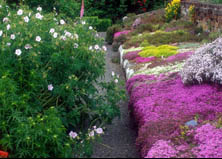A freezing walk to find a very rare lichen!
This is a slight digression from the pampered confines of the walled garden to look 
at what used to be known as one of the 'lower plants', that is lichens, liverworts, mosses and ferns. Today I joined a lichen walk organised by the Natural History Society of Northumbria to look for a very rare species that was last seen and photographed some 14 years ago. High up on the Allendale fells is a famous site, part of a triple SI, in a craggy limestone ravine in a bleakly beautiful landscape. You need permission of the landowner to visit as it is not access land. As we got out of our warm cars it began to snow, blown in striking wind into our faces as we set off on a long, uphill track. Brian Coppins had come down from the Royal Botanic Gardens Edinburgh for this walk; he is senior lichenologist there, a past president of the British Lichen Society, and has been working on a new Lichen Flora for Britain. Also on the walk was Mike Sutcliffe, another leading expert, who works for Natural England and who has created a fabulous website of lichen photos, more of which later.
There are no records yet for some of the area we walked through, and there was much peering at the lichens on a typical sandstone, drystone wall - the sort of thing 
people might easily walk past without a thought. It was seriously cold and as we started to descend into the ravine of Yew Crags on the Wellhope Burn, the snow was driving into my eyeballs like tiny splinters! I don't know why it should be called Yew Crags as there were no yew trees and it is a gorge rather than crags, but the limestone cliffs were unexpectedly dramatic. As well as being home to several rare types of lichen, there were two ferns, the green spleenwort and the hard shield fern. We stopped here for lunch and the snow came down prompting one of the members to tell us that the largest snowflake ever recorded was 38cms across and seen in Montana! When you really start looking, there is huge variety in the form and colours of these underrated plants - from the hairy, silver tresses growing on trees, the brittle miniature tree shapes of Cladonia portenosa, the  favourite of model railway enthusiasts to the grey, orange or yellow of the rock hugging types.
favourite of model railway enthusiasts to the grey, orange or yellow of the rock hugging types.
Setting off down the gorge again we were hunting for the only place in England that
the rare Gyalecta ulmi grows. As it once grew on elm trees and all the elm trees have died, this sole survivor, the size of a handspan, has managed to live on the rockface but finding it among all the cliffs was the difficulty! It was eventually seen on the wrong side of the river and could only be seen close-to by getting wet feet or having wellies on... It formed a grey encrustation against the rock and someone irreverently commented that it looked like a handful of cement had been thrown against a wall! Luckily I was one of the two people wearing wellies and with one foot on either side of the burn and one hand supporting me against the rock, I was able to see it close to. It was too much to try and photograph at that angle, so this is the best picture I could manage from the safety of the other bank.
There are more beautiful lichens admittedly and I absolutely love Mike Sutcliffe's website, britishlichens.co.uk - you can scroll down his picture index which is laid
out in a grid of squares and be dazzled by the sheer decorative qualities of colour, shape and texture. For any artist, it is a fantastic resource for inspiration. I can imagine it being of use to textile artists, 'A' level and art school students, painters and printmakers. We left the gorge and climbed back up again, thankfully warming up with the uphill walk, and the sky cleared, the wide valley views leading the eye to patches of blue amongst clouds in the north. Someone commented that this was the most extreme of the Natural History Society's meetings, so if you want to join, their other events cannot be so cold! I lay in a hot bath with a cup of tea and looked at my 3 foot high bird's nest fern in its pot in the bathroom, glad that it was no longer called a 'lower plant'.


No comments:
Post a Comment